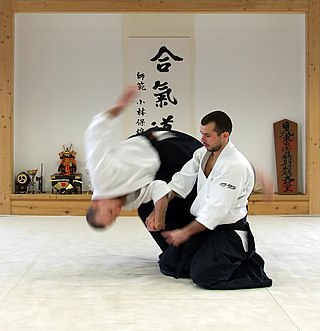
Aikido is a modern Japanese martial art which is split into many different styles including Iwama Ryu, Iwama Shin Shin Aiki Shuren Kai, Shodokan Aikido, Yoshinkan, Renshinkai, Aikikai, and Ki Aikido. Aikido is now practiced in around 140 countries. It was originally developed by Morihei Ueshiba, as a synthesis of his martial studies, philosophy and religious beliefs. Ueshiba's goal was to create an art which practitioners could use to defend themselves while also protecting their attackers from injury. Aikido is often translated as "the way of unifying (with) life energy" or as "the way of harmonious spirit". According to the founder's philosophy, the primary goal in the practice of aikido is to overcome oneself instead of cultivating violence or aggressiveness. Morihei Ueshiba used the phrase masakatsu agatsu katsuhayabi" to refer to this principle.
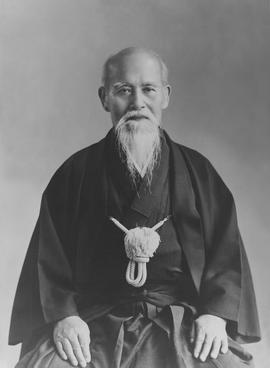
Morihei Ueshiba was a Japanese martial artist and founder of the martial art of aikido. He is often referred to as "the founder" Kaiso (開祖) or Ōsensei (大先生/翁先生), "Great Teacher".

Daitō-ryū Aiki-jūjutsu, originally called Daitō-ryū Jujutsu, is a Japanese martial art that first became widely known in the early 20th century under the headmastership of Takeda Sōkaku. Takeda had extensive training in several martial arts and referred to the style he taught as "Daitō-ryū". Although the school's traditions claim to extend back centuries in Japanese history there are no known extant records regarding the ryū before Takeda. Whether Takeda is regarded as either the restorer or the founder of the art, the known history of Daitō-ryū begins with him. Takeda's best-known student was Morihei Ueshiba, the founder of Aikido.
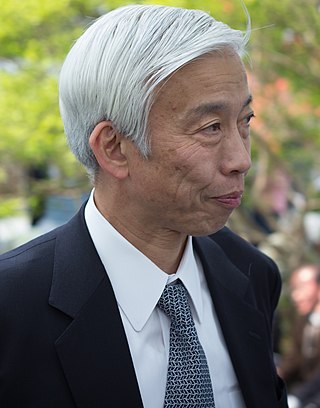
Moriteru Ueshiba is a Japanese master of aikido. He is a grandson of Morihei Ueshiba, founder of aikido, and son of Kisshomaru Ueshiba. Ueshiba is the third and current Doshu of the Aikikai.
Morihiro Saito was a teacher of the Japanese martial art of aikido, with many students around the world. Saito's practice of aikido spanned 56 years, from the age of 18, when he first met aikido founder Morihei Ueshiba, until his death in 2002.
Iwama-style Aikido(岩間合気道) is the style of aikido that was taught in Iwama by the founder of aikido, Morihei Ueshiba, and especially the lineage passed on through Morihiro Saito, a close disciple who was given responsibility over Iwama dojo by Ueshiba.
The Iwama Dōjō is a dōjō built by the founder of aikido, Morihei Ueshiba, who lived there from 1942 until his death in 1969. It is located in the former town of Iwama and became an important historical location for the development of aikido and "a Mecca to the aikido community." This dojo is also where Morihiro Saito, one of the founder's closest students, learned and taught aikido from 1946 until 2002 developing what is often referred to as the Iwama Style.
Gozo Shioda was a Japanese master of aikido who founded the Yoshinkan style of aikido. He was one of aikido founder Morihei Ueshiba's most senior students. Shioda held the rank of 10th dan in aikido.

Shoji Nishio was a prominent Japanese aikido practitioner and innovator. He held the rank of 8th dan shihan from the Aikikai. He was a direct student of Aikido founder Morihei Ueshiba, practiced along with the like of Seigo Yamaguchi and Hiroshi Tada. He also achieved multiple high ranking honors in other martial arts, most notably Iaido, Judo, Karate.
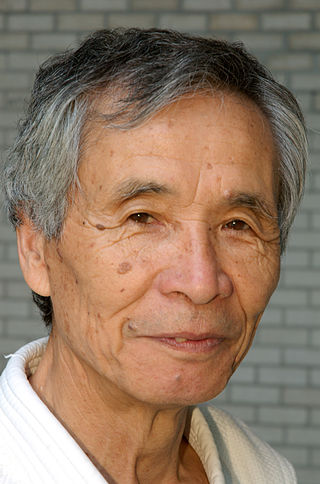
Nobuyoshi Tamura was a prominent aikidoka and a direct student of Morihei Ueshiba. The son of a kendo teacher, Tamura entered the Aikikai Hombu Dojo in 1953 as an uchi-deshi of aikido founder Morihei Ueshiba. He was one of Ueshiba's favorite pupils and since 1964 has greatly contributed to the development of aikido in Europe and France in particular. He was the National Technical Director (DTN) of the FFAB. He held the rank of 8th dan and the title of Shihan. Throughout his teaching career he trained many others instructors in various countries around the world but foremost Western Europe. In 1999, he received the medal of "Chevalier de l'ordre National du Mérite" from the French government. Tamura published several books on aikido in French. His dojo, Shumeikan Dojo, is located in the village of Bras, France. His former students include Jorge Rojo Gutierrez, Toshiro Suga, Pierre Chassang and Alain Peyrache.
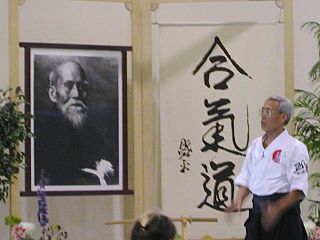
Mitsugi Saotome is a Japanese aikido teacher currently living in the United States. He was a direct disciple of the founder of aikido, Morihei Ueshiba.

Jūkendō (銃剣道) is the Japanese martial art of bayonet fighting, and has been likened to kendo.
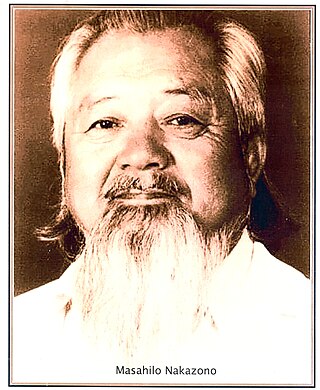
Mutsuro Nakazono ) was a Japanese acupuncturist, an Oriental medicine practitioner, a judo 6th dan and a 7th dan Aikikai aikido master. He studied under Morihei Ueshiba and Ogasawara for many years. Born in the Kagoshima prefecture of Japan, he relocated to France in 1961 where he remained until the early 1970s as a representative of the Aikikai in Europe and North Africa. According to an article by his son, Jei Atacama, Mutsuro Nakazono "changed his name to Masahilo Mikoto Nakazono in his late fifties when he came to realize how his whole life was about his pursuit for 'the truth of life.' 'Masahilo' stood for 'searcher for the beautiful truth of life.'" During this period he was also Chief instructor of Aikido for the international Budo Council. According to Henry Ellis, a pioneer of UK Aikido, Nakazono Sensei's Aikido technique was "the first seen in the U.K. to combine the power found with other instructors, with the grace normally associated with Aikido today." He operated the Nakazono Clinic, a natural healing center in San Diego, California. He moved to Santa Fe, New Mexico in 1972 and lived there until his death in 1994.
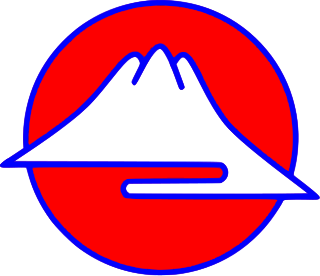
Yoseikan Aikido is the aikido taught at the Yoseikan Dojo in Shizuoka, Japan, under the direction of Minoru Mochizuki.
Kinomichi (氣之道) is a martial art in the tradition of budō, developed from the Japanese art aikido by Masamichi Noro and founded in Paris, France, in 1979. Masamichi Noro was one of the live-in students (uchideshi) of Morihei Ueshiba, the founder of aikido. Designated "Delegate for Europe and Africa" by Morihei Ueshiba, Noro debarked in Marseille on September 3, 1961, preceding Nakazono and Tamura in the communal construction of a European and African aikido. In France, Kinomichi is affiliated with the Fédération Française d’Aïkido, Aïkibudo, Kinomichi et disciplines Associées (FFAAA) and maintains warm relations with the Aikikai Foundation and its leader, Moriteru Ueshiba, the grandson of aikido’s founder.

Kazuaki Tanahashi is an accomplished Japanese calligrapher, Zen teacher, author and translator of Buddhist texts from Japanese and Chinese to English, most notably works by Dogen. He first met Shunryu Suzuki in 1964, and upon reading Suzuki's book Zen Mind, Beginner's Mind he stated, "I could see it's Shobogenzo in a very plain, simple language." He has helped notable Zen teachers author books on Zen Buddhism, such as John Daido Loori. A fellow of the World Academy of Art and Science—Tanahashi is also an environmentalist and peaceworker.
Aikido concepts are ideas that form the philosophical or technical basis of the Japanese martial art aikido.
Tsutomu Yukawa was a Japanese aikidoka.

Stanley A. Pranin was an American martial artist, founding publisher, and editor-in-chief of Aikido Journal. Pranin, a researcher and archivist of aikido, has written and published several books and many articles about aikido, Daito-ryu Aikijujutsu, and Morihei Ueshiba and was an influential figure in the aikido world.
Takako Kunigoshi (1909–2000) was a Japanese practitioner of aikido. She was an early student of Morihei Ueshiba and was one of the first female instructors of the martial art.












